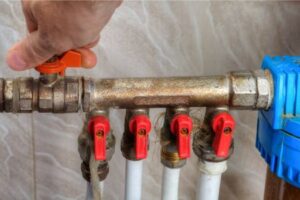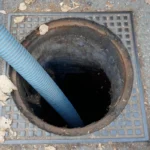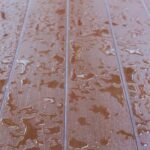When temperatures drop suddenly, few things are more frustrating—or potentially damaging—than discovering your pipes have frozen. Situations where pipes freeze are common in winter, especially for homes with plumbing near exterior walls, uninsulated basements, or drafty crawl spaces.
Frozen pipes are not just an inconvenience. If not handled quickly and correctly, they can burst, causing significant water damage and thousands of dollars in repairs. For many homeowners, it starts with something small—like no water from the faucet or strange noises in the wall. Then panic sets in. What do you do? Can you fix icy pipes yourself? When should you call a pro? Do not worry—we have got answers.
In this guide, we’ll explain exactly what to do when you suspect a pipe has frozen. From spotting the warning signs to thawing the pipe safely and knowing when to call for help, we will cover everything step by step. We will also give you simple tips to prevent this from happening again.
Whether you’re dealing with your first cold snap or you’ve been through this before, this guide will help you act fast and protect your home from serious damage. Let’s dive in!
How to Tell If Your Pipes Are Frozen
No Water Flow
If you turn on a faucet and nothing comes out—or water trickles instead of flowing normally—there is a good chance the pipe feeding that fixture is frozen. This is especially common on cold winter mornings when temperatures have dropped overnight. It usually means ice blocks the line and stops water from passing through. If you notice this, check other taps to see if the issue is isolated or affecting multiple areas. Quick action at this stage can help prevent a pipe from bursting.
Frost on Pipes
Seeing frost or visible ice on the outside of a pipe is a clear indicator that it is frozen inside. This is common with exposed pipes in uninsulated areas like basements, crawl spaces, garages, or along exterior walls. If a pipe feels extremely cold to the touch and shows signs of frost, assume it is frozen and take action. Even if it has not burst yet, pressure is building inside, and you need to deal with it quickly to avoid water damage.
Bulging Spots
If a section of pipe looks swollen, bulging, or oddly shaped, it’s a major red flag. Ice inside a pipe expands and puts pressure on the pipe’s inner and outer walls, causing deformation. This is a sign that the pipe is under stress and could rupture at any moment. If you see this, do not delay—shut off the water immediately and prepare to thaw the pipe or call a professional.
Immediate Steps to Take When You Discover Frozen Pipes
Once you have confirmed that a pipe is frozen, your next move is to minimize the damage and get ahead of a potential burst. Here is where to start:
Shut Off Water
First, you should shut off the main water supply to your home. This prevents water from flooding your property if the pipe bursts while you are trying to thaw it. You will usually find the main shut-off valve in the basement, utility room, or where the water line enters your home. If you do not know where it is, now is a perfect time to learn. If something goes wrong, turning off the water can save thousands of dollars in water damage repairs.
Open Faucets
After shutting off the water supply, open all affected faucets connected to the frozen pipe. This relieves pressure in the system and gives thawed water somewhere to go. Even a small amount of flow helps reduce stress on the pipe walls. Start with the faucet closest to the freeze and work your way outward. This can also help you track how much of the pipe is frozen and whether you’re making progress once you begin thawing.
Locate the Freeze
Try to identify the frozen section of pipe. Start by checking areas that are most exposed to the cold—near exterior walls, crawl spaces, garages, or uninsulated basements. Run your hand along the pipe to feel for extremely cold spots or visible frost. Don’t start cutting drywall if the frozen section is behind a wall or ceiling and can’t be accessed. That is the time to call a professional who can handle it safely without creating additional damage.
How to Safely Thaw Frozen Pipes
Once you have taken the emergency steps, it is time to thaw the pipe. Don’t rush this process; never use unsafe methods like open flames. Here is what you need to know about how to do it right:
Use Hair Dryers
A hairdryer is one of the safest and most accessible tools for thawing a pipe. Set it to medium or high heat and slowly move it along the frozen section of the pipe. Keep it several inches away from the pipe to avoid overheating one spot. Never leave the dryer unattended, and make sure the surrounding area is dry to prevent electrical hazards. This method works best for exposed pipes you can easily reach, such as those under sinks or in basements.
Heating Pads
Electric heating pads or wrap-around heat tape can also be effective. Wrap the pad or tape around the frozen section of the pipe and let it gradually warm the area. This provides steady, controlled heat and is safer than direct heat sources. Be sure to monitor the process, and don’t use damaged cords or plug them into overloaded outlets. This method works well for pipes near water heaters or in utility rooms where you have electrical access.
Towels—Avoid Open Flames
Another method is soaking towels in hot water, wringing them out, and wrapping them around the pipe. This indirect method applies warmth without electricity, but it is much slower. Never use a torch, propane heater, or any open flame to thaw pipes. These can cause fires or damage the pipe, posing serious risks in tight spaces. Stop and call a professional if you can not thaw the pipe safely, or it’s behind a wall or otherwise difficult to see and access.
When to Call a Water Damage Professional
Call a professional water restoration company immediately if a pipe bursts, leaks, or you can’t locate the frozen section. You’re not just dealing with frozen plumbing—you’re now at risk for significant water damage, mold, and structural issues. Professionals have thermal imaging tools to detect frozen or burst pipes behind walls and ceilings. They can also handle drying, cleanup, and repairs safely. If you see wet floors, ceiling stains, or pooling water, don’t wait—bring in the pros before it spreads.
How to Prevent Icy Pipes from Freezing Again
Prevention is the best fix. Once you have dealt with a frozen pipe, the next step is ensuring it does not happen again. Here are three reliable ways to protect your pipes.
Insulation
Start by insulating exposed pipes in crawl spaces, basements, garages, and attics. Use foam pipe insulation sleeves or wraps that are easily installed and widely available. Insulating pipes help maintain a safe temperature during cold weather. Also, check around exterior walls and windows—insulating these areas can help keep the room warm enough to protect pipes inside.
Heat Tape
Heat tape is a smart upgrade for pipes that are especially prone to freezing. This electrical tape wraps around the pipe and provides low, consistent heat during freezing temperatures. Make sure to follow the manufacturer’s instructions and use tape-rated for residential plumbing. Heat tape works well for outdoor pipes or areas where insulation alone isn’t enough.
Letting Faucets Drip
On freezing nights, let a few faucets run at a slow trickle. Moving water is less likely to freeze, and this small step can prevent pressure buildup inside the pipe. Focus on faucets connected to pipes near exterior walls or in cold spaces. It’s a simple and effective trick, especially if you have had issues in the past.
Get Emergency Help When You Need It Most for Icy Pipes
Frozen pipes can be much more than just an inconvenience—they can be a serious risk to your home. Whether you find yourself dealing with reduced water flow, a burst pipe, or signs of water damage, you need fast, professional help to deal with the potential water issues. Acting quickly can be the difference between a minor repair and a full-blown restoration job.
💧 Call SS Water Renovations today for emergency pipe thawing, leak detection, and water damage cleanup. Our team is trained, equipped, and ready 24/7 to protect your home and quickly restore normalcy.
FAQs For Pipes Freeze in the Home
1. How do I know if my pipes are frozen?
2. Can I thaw frozen pipes myself?
3. What should I do if a pipe bursts?
4. How can I prevent frozen pipes?
5. Does the homeowner’s insurance cover frozen pipes?









